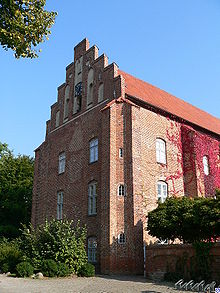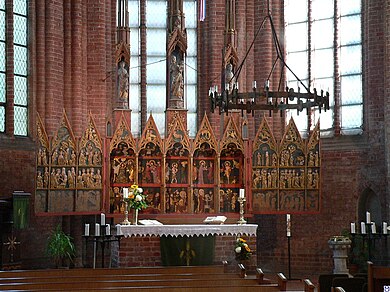You can help expand this article with text translated from the corresponding article in German. (August 2022) Click for important translation instructions.
|

Cismar Abbey (German: Kloster Cismar) was a Benedictine monastery located at Cismar [de] near Grömitz, Schleswig-Holstein, in Germany.
History
The abbey was founded in 1238 by Count Adolf IV of Holstein as alternative accommodation for Benedictine monks from Lübeck. In the mid-15th century it was one of the six original members of the influential Bursfelde Congregation, a Benedictine reform movement. After three prosperous centuries, based largely on its possession of a relic of the blood of Christ and a healing spring dedicated to John the Baptist, which made it a centre of pilgrimage, it was dissolved in 1561 during the secularisation brought about by the Reformation. The monastic library is preserved in the Danish Royal Library in Copenhagen.
The Brick Gothic abbey church is famous for its carved altar, dating from the early 14th century, still in place in the church.

The other surviving buildings, after a wide variety of secular uses, now serve as a museum.
References
- ^ Grabowsky, Anna-Therese: Das Kloster Cismar, Karl Wachholtz Verlag Neumünster, 1982
- ^ Cismar.de: local information website, including Cismar Abbey
External links
54°11′24″N 10°59′09″E / 54.19000°N 10.98583°E / 54.19000; 10.98583
This article about a Schleswig-Holstein building or structure is a stub. You can help Misplaced Pages by expanding it. |
This article about a Christian monastery, abbey, priory or other religious house is a stub. You can help Misplaced Pages by expanding it. |
- Benedictine monasteries in Germany
- Monasteries in Schleswig-Holstein
- 1230s establishments in the Holy Roman Empire
- 1238 establishments in Europe
- Christian monasteries established in the 1230s
- Museums in Schleswig-Holstein
- Religious museums in Germany
- Lutheran churches in Schleswig-Holstein
- Lutheran churches converted from Roman Catholicism
- Brick Gothic
- Gothic architecture in Germany
- Schleswig-Holstein building and structure stubs
- Christian monastery stubs